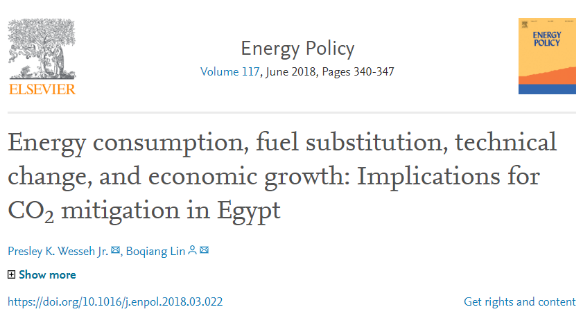
题目:能源消耗、燃料替代、技术变化和经济增长:对埃及缓解二氧化碳排放的启示(Energy consumption, fuel substitution, technical change, and economic growth: Implications for CO2 mitigation in Egypt)
作者:Presley K.Wesseh Jr.,林伯强*
期刊:能源政策(Energy policy)
详细:117卷,2018年6月,340-347页
DOI:https://doi.org/10.1016/j.enpol.2018.03.022
文献导读:
大量研究表明,能源消费对一个国家的经济增长至关重要。近年来,以化石能源为主的二氧化碳排放的持续增加引发了全球对气候变化的担忧。国际能源署(IEA)报告称,全球将近49%的二氧化碳排放来自能源消费。发展中国家工业化和城市化过程伴随的高能源强度是全球碳排放居高不下的重要原因之一。政府可以通过三种方式降低二氧化碳排放率。首先是制定节能措施;其次是扩大对清洁能源的投资;最后是利用碳税、碳排放交易计划、碳捕获和储存等措施。随着经济的增长和快速扩张,埃及能源消耗和二氧化碳排放量急剧上升。埃及是非洲最大的石油消费国,约41%的电力和45%的一次能源来自石油。此外,埃及的能源消耗和二氧化碳排放存在共同趋势。
文章采用埃及1980-2016年的年度数据,采用超越对数生产函数和岭回归对各种能源类型与埃及经济增长之间的因果关系进行建模,以估计不同能源类型间的替代弹性,并量化燃料间替代的减排潜力。文章使用的分析方法不仅重新定义了产出和投入之间的因果关系,还包含了各种能源形式之间的相互作用以及这些投入要素间的技术进步水平。
研究结果展示了从电力消费到其他能源形式(即石油和天然气)的单向因果关系,以及所有能源形式(即电力、石油和天然气)与经济增长之间的双向关系。利用模型估计得到的产出弹性,文章计算出各种能源燃料之间的替代弹性。研究发现,石油与电力、天然气之间具有很强的替代性。这表明,埃及有可能通过限制使用石油消费来推动本国经济发展,同时这也能节省用于石油消费补贴的巨额预算。第三,埃及的技术进步主要是由投入要素所驱动的,技术进步率在4.5%-7.5%之间波动。如果在5%的投资情景下,燃料替代带来的二氧化碳减排效益相当于减少150-220万吨的排放量;而在10%的投资情景下,则能减少250-450万吨的排放量。该研究对发展中国家制定节能政策和产业并购政策具有一定的政策启示。同时为能源效率驱动下的二氧化碳减排潜力研究提供了一个新的分析视角。
Abstract:
Energy consumption propels economic growth but the level of CO2 emissions associated with a fossil-dominated energy structure raises concerns for the fight against climate change. To draw consensus, this study develops a translog-causality-based model in order to study causation between electricity, natural gas, petroleum, and economic growth in Egypt. In addition, the models’ results are used to estimate the substitution possibilities between various energy pairs and to subsequently test the CO2 mitigation benefits arising from fuel substitution. Results support a bidirectional relationship between all energy types and economic growth in Egypt and suggest, also, that these energy types are substitutes. Although technical progress is estimated to be a bit slow (varying between 4.5% and 7.5%), there appears to be substantial CO2 emissions mitigation benefits from fuel substitution amounting to reductions in the range of 1.5 and 2.2 million metric tons under a 5% investment scenario and 2.5 and 4.5 million metric tons under a 10% investment scenario. These results have broader implications for energy conservation policies and industrial merger policies in developing countries. Moreover, by studying technical change, insights are provided on future CO2 mitigation potential driven by energy efficiency.
Keywords: Energy consumption; Fuel substitution; Technical change; Mitigation; Economic growth
 厦大总机:0592-2180000
|
地址:福建省厦门市思明区思明南路422号
|
邮政编码:361005
厦大总机:0592-2180000
|
地址:福建省厦门市思明区思明南路422号
|
邮政编码:361005